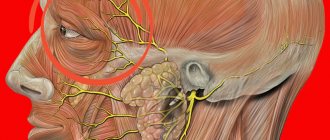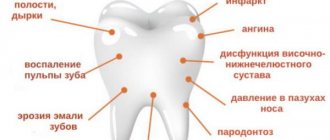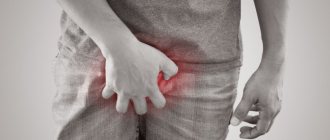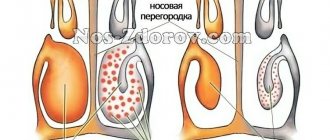Etiology [causes]
Often pain is concentrated in the lower jaw. The pain may be on the right side, the left, or the entire joint. In some cases, the pain radiates to the ears, the back of the head or the frontal part.
Jaw pain is caused by the following pathologies:
- diseases of the gums or teeth. Then it hurts simultaneously on both sides of the lower jaw, with shooting in the ears;
- the functioning of the sinuses responsible for air circulation is disrupted. With a high probability it can be said that an abscess with pus forms in them;
- inflammation or infection focused on the tonsils or throat;
- diseases of the peripheral nervous system;
- inflammatory processes in the lymph nodes;
- damaged bone tissue;
- injury (bruise) to the jaw or damaged joint. They can be recognized by their characteristic feature: a person cannot open his mouth;
- diseases that have no connection with the facial skeleton, but cause pain in the jaw area. When the jaw is cramped, this may indicate the presence of tetanus, mumps, or red ear syndrome.
If the pain seems to rise from the bottom left, from the region of the heart, simultaneously radiating to the left arm, there is a danger of angina pectoris or myocardial infarction. You need to immediately go to an emergency room, where a paramedic will take an electrocardiogram and rule out or confirm one of the diseases.
A very dangerous type of traumatic injury to the face is a fracture of the lower jaw, which is accompanied by the following consequences:
- one row of teeth is displaced relative to the second (there are two possible displacement options: either up or back);
- cracks form between the teeth along the line where the jaw is broken;
- jaw fragments are displaced under the influence of muscle force and gravity;
- teeth are displaced relative to their usual location;
- malocclusions are formed;
- it is impossible to move the jaw, since the pain when trying to open the mouth intensifies to unbearable;
- it is difficult for a person to breathe, speak, swallow and chew;
- the lower part of the face becomes numb (lips and chin area);
- if the fracture is double, the tongue sinks;
- dizziness, nausea to vomiting, severe pain in the head.
In addition, a fracture causes disruptions in the functioning of other organs. An example is a concussion that occurs as a result of a strong blow to the jaw, resulting in its fracture (boxers suffer from a similar injury).
Pain in the jaw can also be caused by cancerous formations concentrated in bone tissue, or osteogenic sarcoma. Before pain appears, the jaw begins to go numb. Numbness is caused by loss of sensation at the nerve endings.
The tumor can also be benign; it is called atheroma. It appears as a lump on the skin behind or next to the ear. This occurs because the lymph node increases in size. The atheroma feels like a ball, it is under the skin and moves. This tumor itself is not dangerous, however, if it is not eliminated, inflammation or an abscess may occur in its place. This is expressed in increased temperature, headache, redness of the skin in the area of atheroma. In a particularly severe case, pus begins to move throughout the body and, when it enters the blood, causes infection.
If the jaw hurts while chewing food, most likely it is dislocated, or the person has osteomyelitis. Dislocation is easy to determine externally.
If both of these pathologies are excluded, you should consult a dentist and be checked for diseases such as periodontitis, caries with abscess or nerve inflammation, and pulpitis. The nature of the pain in such cases is pulsating, intensifying in the evening and at night.
Pain due to jaw injury
Pain is a common symptom of jaw injuries. The severity of pain and accompanying symptoms is determined by the nature of the injury.
Bruise of the jaw area
A bruise is the mildest type of injury, in which only soft tissue is damaged, while the bone is not damaged. When the face is bruised in the area of the upper or lower jaw, acute pain, swelling, and bruising occur. These symptoms are not very pronounced and disappear completely within a few days.
If there is an injury accompanied by a bruise to the face and pain in the jaw, it is worth visiting the emergency room and undergoing an x-ray to rule out more serious injuries.
Jaw fracture
A jaw fracture is a fairly serious injury. At the time of injury, severe sharp pain occurs in the jaw, severe swelling and hemorrhage under the skin. When moving the jaw, the pain intensifies significantly. If there is a fracture of the lower jaw, then the patient is completely unable to open his mouth; attempts cause very severe pain.
Fractures of the upper jaw are especially serious. If the pain is accompanied by hemorrhage around the eye sockets (the so-called “spectacles symptom”), then there is every reason to suspect a fracture of the base of the skull. If droplets of blood or clear liquid come out of the ears, the injury is very serious. You need to call an ambulance immediately.
In the trauma center, for the purpose of more accurate diagnosis, an X-ray examination is performed. After establishing the nature of the fracture, a special bandage is applied, or surgical treatment is resorted to. Fractures of the base of the skull are treated only in a hospital.
Dislocation
Dislocation of the lower jaw is an injury that usually occurs when the mouth is suddenly opened. Most often it happens to people who are used to opening bottles and all kinds of hard packaging with their teeth, and have joint diseases in the form of arthritis, rheumatism and gout.
At the moment of dislocation, a fairly strong sharp pain occurs in the area of the lower jaw and the temporomandibular joint. At the same time, other symptoms occur:
- the mouth is fixed in an open position, making it very difficult for the patient to close it;
- the lower jaw is not in the correct position: it is pushed forward, or beveled to one side;
- naturally, this leads to speech impairment: if no one was nearby and saw how it happened, it can be difficult for the patient to explain what happened to him;
- since it is impossible to swallow saliva normally, it is released in large quantities and flows out of the mouth.
An emergency room doctor diagnoses a dislocation very easily - when he sees a person with his mouth wide open, complaining of severe pain in the lower jaw joint. Reduction is carried out manually. After this, an x-ray is prescribed to rule out a fracture.
Pain after a jaw fracture
Sometimes after a jaw fracture, in the long term, patients are bothered by aching pain. In this case, they may be due to:
- damage to the necks, ligaments of teeth and gums by the wire with which the doctor fixes the splint;
- repeated fracture or displacement of fragments, if sharp pain in the jaw is again accompanied by swelling and hemorrhage;
- massive trauma and nerve damage.
If pain occurs after an injury, you can take painkillers. If they do not help, and the pain is very strong and does not go away for a long time, then you need to consult a doctor.
Symptoms
It is difficult to independently diagnose and establish the cause of jaw pain. It's better to consult a specialist.
Jaw pain is usually accompanied by the following symptoms:
- increased discomfort when pressing on the area where the pain is concentrated;
- gives to the neck;
- goes to the back of the head and temples;
- stitches in the shoulder blades;
- When you try to open your mouth, there is a crunching sound and noise in the ears.
If jaw pain is accompanied by tinnitus or tinnitus, you should immediately contact an otolaryngologist, as this combination of symptoms can lead to hearing loss or even complete loss.
If the mouth cannot be opened completely, the jaw moves. This leads to problems with the gums, tooth enamel is gradually worn away, and teeth sensitivity to hot and cold foods increases.
Since constant unpleasant sensations in the jaw cause tightness in the muscle tissue (a person is under tension every minute), other consequences can be provoked:
- nagging and aching pain in the upper back (scapula);
- worsening sleep, insomnia;
- depression, bad mood, fatigue, lethargy, apathy;
- dizziness, poor spatial orientation;
- photosensitivity;
- eye pain, blurred vision.
Pain in the jaw of neurogenic origin
When certain nerves are damaged, pain radiates to the jaw: 1.
Trigeminal neuralgia.
The trigeminal nerve is responsible for sensory innervation of the entire face.
When its lower branch is affected, the pain radiates to the jaw. It is very strong, sharp, and occurs in attacks, usually at night. The nature of the pain is boring, burning. It worries only on one side, since nerve damage is in most cases unilateral. It is characteristic that pain with such neuralgia never spreads behind the jaw. 2. Neuralgia of the superior laryngeal nerve.
In this case, quite intense pain occurs under the lower jaw, on the right or left.
It can spread to the face and chest. Pain occurs during yawning, chewing, and blowing the nose. Often the patient is simultaneously bothered by coughing, drooling, and hiccups. 3. Neuralgia of the glossopharyngeal nerve.
This is a fairly rare pathology. It is characterized by pain that occurs in the tongue, and then radiates to the lower jaw, pharynx and larynx, face, and chest. Provoking factors for the occurrence of pain are: tongue movements, talking, eating. Usually the pain lasts no more than three minutes and is accompanied by severe dry mouth. After an attack, on the contrary, increased salivation is a concern.
Treatment of pain in the jaws due to nerve damage depends on the nature of the pathology. Usually, medications are first prescribed, and if they are ineffective, they resort to surgical division of the nerves.
Doctors
Jaw pain is a symptom that, occurring for various reasons, may require consultation with various doctors. To rule out problems with teeth and gums, you will have to make an appointment with a dentist. A traumatologist or surgeon can confirm or deny the presence of jaw injuries. An otolaryngologist can rule out abscesses, inflammation or infections in the throat and ears. And finally, the therapist will answer the question: does the patient have problems with the heart and blood vessels? It will also eliminate tetanus and mumps.
If, after visiting all the listed doctors, the cause of the pain in the jaw has not been identified, you need to consult with an oncologist about the presence of tumors in the jaw - benign or not.
Vascular diseases
A sufficient supply of blood is a prerequisite for the normal functioning of any tissue or organ of the human body, including the jaws. As soon as the blood flow is disrupted, pain and various other symptoms immediately appear.
Pain in the jaws is observed with the following vascular pathologies: 1.
Arteritis of the facial artery
is accompanied by burning pain in the jaws.
In this case, pain can occur in the lower jaw (along the lower edge, from the chin to the corner) or the upper jaw (in the area of the wings of the nose and upper lip). The most typical location of pain is the middle of the lower edge of the lower jaw - where the facial artery bends through it. Pain sensations radiate to the inside of the eye. 2. Damage to the carotid artery
, the origin of which is not entirely clear, is today considered a type of migraine. Pain occurs in the lower jaw and under it, in the neck, teeth, ear, and sometimes in the corresponding half of the face. Painful sensations can be provoked by palpating the area of the carotid artery.
For jaw pain caused by vascular pathologies, special medications are used.
Diagnostics
Since the range of diseases that cause jaw pain is wide, they are diagnosed in different ways.
Any kind of traumatic injury is detected by x-ray (except for dislocation - it is visible to the naked eye). In the vast majority of cases, bruises are accompanied by soft tissue swelling and hematomas (bruises).
Diseases of the teeth and gums can be partially diagnosed during examination by a doctor, however, pathologies such as cysts are also detected through x-ray examination.
To exclude the presence of oncological formations, an MRI (magnetic resonance imaging) of the head is prescribed.
Angina pectoris and myocardial infarction are diagnosed by taking an electrocardiogram and listening to heart sounds.
Migraine diagnosis is simple. Usually a person suffering from its attacks informs the doctor about the presence of the disease.
Diseases of the ears, nose and throat are diagnosed by an otolaryngologist through a visual examination of the patient’s relevant organs. If necessary, he takes swabs.
Causes of pain in the lower jaw
In cases of injury to the lower jaw, the bite and reaction to palpation are initially checked. A visual inspection is carried out for the presence of bruising, swelling, and closed deformities.
Infectious diseases include: dental abscess, osteomyelitis, actinomycosis. With a dental abscess, hypermia of the mucous membrane and the appearance of a painful new formation of a loose structure are observed. In some situations, the disease appears externally on the skin of the lower jaw. The lymph nodes in the neck become enlarged, gingivitis (inflammation of the gums) and caries appear. Acute osteomyelitis is characterized by problems with swallowing, the mouth is difficult to close due to muscle swelling. As a result, there is pain in the lower jaw, tissue hyperemia, and pain when swallowing. Actinomycosis is characterized by the presence of many passages with greenish-yellow contents located in the lower corner of the jaw.
Dysfunction of the temporomandibular joint is accompanied by spasm of the masticatory muscles and trismus, in which the jaws close tightly. Rheumatoid arthritis causes pain during examination and swelling in the joint, and osteoarthritis limits the movement of the joint with the formation of swelling. In patients with dislocation of the temporomandibular joint, the mouth does not close; during palpation, condyles are discovered that are displaced forward from the articular tubercle.
A developing cyst of the lower jaw only causes swelling. Some cases of the disease lead to severe bone thinning, when the slightest touch can break it.
Neoplasms that cause pain in the lower jaw: giant cell granuloma, osteogenic sarcoma, Burkitt's lymphoma. With giant cell granuloma, erosive surfaces appear, bones are destroyed, and purple-bluish formations appear on the gums. The initial appearance of osteogenic sarcoma goes unnoticed due to the lack of pain. Its growth causes loose teeth. Burkitt's lymphoma is a disease with progressive enlargement of the tumor, displacing the auricle and limiting oral opening. The tumor develops painful metastases in the bones.
ilive.com.ua
Treatment
To get rid of jaw pain, you need to undergo diagnostics and find out the cause. This is the first and main condition for healing. Self-medication in this case is not only useless, but even harmful, because if you uncontrollably throw yourself on painkillers or treat the wrong disease, you can worsen the disease. And then a much more serious course of rehabilitation will be required.
There are different types of treatment for each disease.
To eliminate the consequences of a jaw bruise, cold compresses are applied to the injured area. A dislocated jaw can be corrected by both a surgeon and a traumatologist. It is under no circumstances recommended to adjust dislocations on your own. Even if the victim has a medical education.
In case of a jaw fracture with displacement of bone fragments, surgical intervention is required. If the fracture is not displaced, the jaw is rigidly fixed on splints and the patient is given therapy against microbes and for general strengthening of the body through antibiotics and vitamins. Typically, healing of a fracture that is not complicated by displacement takes 3 to 4 weeks.
If there is an abscess on the face, then it needs to be opened (this is also done by a surgeon); after the forced release of pus, antibacterial treatment is carried out.
If pain in the jaw is provoked by attacks of carotidynia (this is the name of one of the types of migraines), it can be treated with the help of antidepressants and painkillers - the same ones that are prescribed for the treatment of migraines.
When jaw pain is caused by angina pectoris or myocardial infarction, a person needs emergency medical attention. In an inpatient setting, the patient is treated with thrombolytics, substances that lower blood pressure, and analgesics that make thick blood more fluid.
For pain caused by periodontitis or other dental diseases, it is necessary to sanitize the oral cavity. In case of pulpitis, cyst or periodontitis, surgery will be required. It is also needed if a person’s wisdom tooth is cut incorrectly.
Oncological tumors are treated either surgically or mixed - a combination of irradiation of oncogenic cells and chemotherapy.
When a joint clicks
If your jaw is clicking on one or both sides, the following exercises are recommended:
- move the lower jaw back and forth 10 times in each direction;
- relax your mouth, open your lips and move your jaw left and right 10 times;
- press your fingers on your chin and, using muscle efforts, try to lift your jaw up, do this for 30 seconds;
- place your fingers on both sides of the chin and try to push it forward with force, continue for about 30 seconds.
Recommendations
To facilitate the treatment process and make it the least expensive both in terms of finances and time, it is recommended:
- If you receive a jaw injury, immediately contact the on-duty traumatology department and ask for an x-ray;
- if the injury is a dislocation, it must be adjusted in the same traumatology department, without waiting for other consequences to occur;
- if you suspect a myocardial infarction or an angina attack, call an ambulance or, if possible, get to the nearest ambulance station yourself. Ask to take an electrocardiogram and listen to heart sounds;
- in case of a migraine attack (carotidynia), take the painkiller prescribed by the doctor and make an appointment with a therapist as soon as possible. This must be done even when the attack was quickly stopped, avoiding severe pain;
- in a situation where you are concerned about the condition of your teeth and/or gums, make an unscheduled visit to the dentist and eliminate all identified defects in the oral cavity;
- if pain in the jaw is accompanied by ringing, noise or stuffy ears, as well as dizziness, immediately consult an otolaryngologist and begin treatment without delay.
Causes of pain under the lower jaw
There are a large number of anatomical formations under the lower jaw. When they are damaged, pain may develop that radiates to the jaw.
First of all, it is worth considering pathologies associated with the submandibular lymph nodes. An inflammatory process (lymphadenitis) can develop in them. In this case, the infection enters the lymph nodes with the flow of blood or lymph from diseased teeth, during injuries. In acute lymphadenitis, there is a sharp pain under the lower jaw, increased body temperature, general weakness and malaise. Without appropriate treatment, this disease can become chronic. In this case, an enlarged lymph node can be clearly felt under the lower jaw. Periodically, the process worsens, which is accompanied by the recurrence of acute pain. Submandibular lymphadenitis can lead to purulent-inflammatory processes such as submandibular phlegmon and abscess.
Tumors of the submandibular lymph nodes
most often they are metastases that penetrate into them from the jaw itself or other organs.
In this case, there is an increase in lymph nodes for a long time, their adhesion to the skin and other neighboring tissues. There are chronic pains under the jaw of various types. Other symptoms: slight increase in body temperature for a long time, weakness, malaise, weight loss. The doctor who conducts the diagnosis must ultimately answer two questions: 1.
What is happening in this case: lymphadenitis or metastases in the lymph nodes?
2.
If these are metastases, then from which organ did they spread?
Glosalgia
– increased sensitivity of the tongue. There is pain that radiates to the lower jaw. Attacks of glossalgia are provoked by prolonged conversation, chewing rough food, eating cold, hot, spicy, sour foods, etc.
Glossitis is an inflammatory lesion of the tongue, which also causes pain under the lower jaw. When examining the oral cavity, the tongue appears thickened and has a bright red color. Over a long period of time, glossitis can transform into submandibular phlegmon or abscess. In this case, there is pain radiating to the lower jaw.
Sialoliths
- salivary stone disease. It is accompanied by mild pain under the lower jaw and pain when pressing on the affected area. Salivary stone disease of the sublingual and submandibular salivary glands leads to pain in the lower jaw. Other characteristic symptoms of this disease:
- swelling under the lower jaw, usually only on the right or left;
- pus is released from the duct of the gland that opens in the oral cavity, as a result of which the patient is bothered by an unpleasant odor in the mouth;
- if the process worsens, then classic signs of inflammation occur: increased body temperature, malaise, weakness.
Sialadenitis is inflammation of the salivary glands. With the development of the inflammatory process in the sublingual and submandibular glands, pain under the lower jaw, increased body temperature, and malaise are noted. The process can transform into an abscess or phlegmon.
Benign and malignant tumors of the salivary glands
manifest themselves in the form of prolonged pain under the lower jaw of low intensity. With a malignant course and metastasis, there is an increase and pain in nearby lymph nodes, exhaustion, and weakness.
For pharyngitis
(inflammation of the pharynx) patients in some cases are bothered by pain in the throat and lower jaw. There is a sore throat and cough.
Sore throat (tonsillitis) is an inflammation of the tonsils, manifested in the form of severe pain in the throat when swallowing. In this case, the pain can radiate to the jaw and ear. Body temperature rises and other signs of respiratory infection may occur.
Tumors of the larynx.
When the laryngeal nerve is irritated by a tumor, the pain spreads to the chest, lower jaw, and ear. Typically, pain increases gradually over a long period of time. The patient is worried about a “lump”, a feeling of a foreign body in the throat, soreness, cough, voice disturbance. And with large tumors, difficulty breathing occurs.
Prevention
To prevent treatment of the jaw, you should try to avoid bruises, injuries and damage. This applies to both blows and chewing too hard food.
After eating, be sure to brush your teeth with a dentist-recommended toothbrush or floss. It is not advisable to use toothpicks, especially if the gums are prone to bleeding - you can easily injure the gums and allow infection to get into the wound.
If the dentist identifies an incorrect bite, it must be corrected under the supervision of a specialist.
Any pathologies of the teeth and gums must be eliminated immediately, without causing minor caries to develop into pulpitis. Once every six months you need to visit a dentist, ideally the same one who is familiar with the patient’s oral cavity and teeth. If you have persistent dental problems, it is better if the visits are more frequent - for example, once every 3-4 months. A preventive examination and timely detection and elimination of minor defects will help to avoid more serious and expensive treatment in the future.
You should not clench your teeth or grind them; excessive tension in the jaw muscles leads to their incorrect position. In addition, clenching your teeth has a bad effect on skin turgor - expression wrinkles are formed.
You cannot carry weights on one shoulder; you need to distribute the load evenly across both shoulders. If this is not possible, you need to change the shoulder more often, reweighing the bag. To avoid distortions in the shoulder girdle, the optimal solution would be to purchase a backpack with wide straps. This will help maintain your posture at the same time.
3.Dysfunction of the temporomandibular joint
It provokes pain not only in the joint (in front of the ear), but also in the forehead, temples, lower jaw, and cheeks. The pain is accompanied by a clicking sound or limited movement of the joint. Pain can often occur due to myofascial syndrome (reflex spasm) in the masticatory muscles, malocclusion, inflammatory, or degenerative changes in the joints. The examination helps to identify pain in a specific place, a characteristic crunch when opening the mouth, incorrect position of the joint surfaces and limited movement of the lower jaw.
Back to contents
Bibliography
When writing the article, the dentist used the following materials:
- Bark K., Burgorf V., Hede N. Diseases of the mucous membrane of the oral cavity and lips. Clinic. Diagnosis and treatment. Atlas and guide; Medical literature - M, 2011. - 438 p.
- Borovsky, E.V.; Danilevsky, N.F. Atlas of diseases of the oral mucosa; M.: Medicine - M, 2009. - 288 p.
- Kilafyan O. A. Oral hygiene. Short course; Phoenix - M, 2014. - 224 p.
- Rabinovich A. S. Chronic focal infection of the oral cavity; State Publishing House of Medical Literature - M, 2009. - 168 p.
- Kozlov, Valentin Ivanovich Anatomy of the oral cavity and teeth [Text]: textbook / V. I. Kozlov, T. A. Tsekhmistrenko. — 3rd ed., erased. - M: Russian Peoples' Friendship University, 2020. - 155 p. ISBN 978-5-209-08288-0
- Diseases of the teeth and oral cavity; GEOTAR-Media - M, 2012. - 248 p.
- Therapeutic dentistry. Diseases of the oral mucosa. In 3 parts. Part 3; GEOTAR-Media - M, 2013. - 256 p.
- Makeeva I. M., Sokhov S. T., Alimova M. Ya. Diseases of the teeth and oral cavity. Textbook; GEOTAR-Media - M, 2014. - 252 p.
Why is there a problem?
According to medical statistics, in most clinical cases the lower jaw hurts due to dysfunction of the temporomandibular joint (hereinafter referred to as TMJ). Severe discomfort can haunt people for years - the disease progresses, pain is accompanied by difficulty opening the mouth, clicking in the joint, and disturbances in the “working” of the jaw itself while chewing food.
Pain when opening the mouth directly indicates TMJ dysfunction. So, the joint can hurt severely (discomfort suddenly appears and also disappears), then we are talking about an acute form of the disease. If the patient experiences moderate periodic pain for a long period of time, the abnormal process has entered the chronic phase.
Why does the TMJ hurt: many patients experience discomfort the day after visiting the dentist, when they had to keep their mouth open for a long time (it is difficult to chew food, it seems that the bite is “out of alignment”). Usually, cold compresses and moderate stress on the “affected” joint help relieve local discomfort for at least 2–3 days.
The problem is that in the absence of chewing units, the entire load passes from the teeth to the bone. The masticatory muscles, in turn, gradually “squeeze” the head of the TMJ into the glenoid cavity. This leads to chronic pain in the lower jaw and can, moreover, be complicated by an inflammatory process (arthrosis transforms into arthritis).












